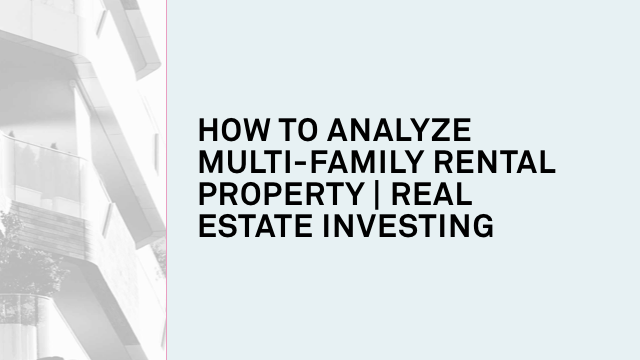Table of Contents
Despite the competition for multifamily deals, there is no shortage of investment opportunities. In fact, most investors will look at 100+ deals before finding one that warrants serious consideration. Even then, a robust due diligence process may negate the opportunity.
As a prospective investor, it is important to understand what goes into this due diligence process. In this article, we’ll assume that a sponsor has already conducted its own due diligence on a deal. Let’s say sponsors have brought you five multifamily investment opportunities to consider. How do you decide which to move forward with—if at all?
Read on to learn more about how to analyze multifamily investment opportunities.
Why Due Diligence is Important Before Investing in Multifamily
The need to conduct thorough due diligence on a multifamily deal is extremely important. All too often, people blindly trust the sponsor who has proposed the deal. Perhaps the sponsor is a childhood friend or someone who they play golf with recreationally. After all, this is how most syndications have historically found capital (i.e., friends and family).

Today, though, with the advent of online real estate crowdfunding, sponsors can solicit more broadly. Often, sponsors are pooling capital from people with whom they have no pre-existing relationship. This has also opened the doors to more deals for passive investors.
With access to more investment opportunities, deciphering the good from the great can be challenging.
Yet, due diligence is critical. Multifamily investments, particularly development deals or heavy value-add projects, can be risky. It is important to invest with a sponsor who has a concrete plan for mitigating this risk, which you will only know by analyzing each deal yourself.
Key Steps in the Due Diligence Process
Most investors have their own unique process for analyzing multifamily investment opportunities. However, regardless of the processes they utilize, most will – at a minimum – take the following steps:
01  Evaluate Hyperlocal Market Conditions
Evaluate Hyperlocal Market Conditions
The value of any commercial real estate depends on the hyperlocal market conditions. This is especially true of a multifamily deal. Before investing, consider the local market.
Explore the following questions:
- What’s the demographic profile of local residents?
- What’s the area’s median household income?
- Is the area experiencing in-migration, out-migration, or is the population stagnant?
- What’s bringing people to the area? Why would people be moving in or out?
- How is the local job market? Who are the major employers? Is there any risk of one major employer leaving (and therefore, residents no longer needing housing)?
- How are the local schools? What other amenities exist (parks, retail, etc.)?
- What’s the crime rate? What type of crime is most common (violent vs. property)?
- What is the breakdown of single-family homes vs. multifamily rentals in the area?
- What is the demographic of local renters?
- What sort of multifamily competition exists today? What is the condition of those properties? What are asking rents / vacancy rates at those properties?
- Is there any new multifamily development in the pipeline? How will that impact the supply/demand equation?
These questions are all important because it gives you a sense for how the multifamily investment opportunity under consideration will perform. For example, if an area has experienced a surge of new multifamily construction already, it may be difficult to fill a new development that follows (or to achieve anticipated rents).
Conversely, if there is a lot of new job growth in the area. It is likely that more multifamily might be needed. Understanding these dynamics is critical.
The value of any commercial real estate
depends on the hyperlocal market conditions
02  Consider the Condition of the Property
Consider the Condition of the Property
In the case of a multifamily acquisition, consider the condition of the property. Is it well maintained or is it facing significant capital expenditures (e.g., a new roof, driveway, heating systems, etc.)? Look at the condition of individual units. Can these be leased as-is, or will renovations be necessary?
If the latter, what is the extent of the renovations needed? A light value-add strategy might be sufficient (e.g., new paint, carpets and light fixtures). Heavy value-add deals are also worth considering, as these can be highly lucrative, but are generally best executed by experienced sponsors.
The condition of the property and extent of renovations ties back to the market analysis above. For example, if there has been an influx of new construction, a heavy value-add strategy might be necessary to keep pace with local rents. However, if the market leans toward price-conscious middle-class renters, more modest upgrades might be all that is needed.
03  Carefully Vet the Sponsor & Their Business Plan
Carefully Vet the Sponsor & Their Business Plan
The sponsor, or general partner, serves as the “quarterback” of a real estate syndication. They are making all business decisions on behalf of their passive, or limited partner, investors. Therefore, it is important that you implicitly trust the sponsor to act on your behalf.
The sponsor, or general partner, serves as
the “quarterback” of a real estate syndication.
Start by analyzing the sponsor. Who is on their team? How long have they been in business? Do they have experience with this property type and/or geography? How have their previous deals performed? Have they weathered previous economic downturns, and if so, how?
Then look at the sponsor’s business plan. Even if you’ve invested with a sponsor before and trust them, the business plan for each deal is different.
In terms of the business plan, look at how they plan to finance the deal, what renovations are planned, the lease-up and stabilization strategy, the hold period, and the intended disposition strategy (if any). Be sure this aligns with your expectations and investment goals.
04  Examine the Financials and Test Assumptions
Examine the Financials and Test Assumptions
Understanding the sponsor’s fees and financials is also very important. All too often, investors will only look at the promised returns (e.g., the cap rate, IRR and cash-on-cash returns). This only scratches the surface. You need to dig deeper to see how the sponsor came to its conclusions about achieving those returns.
Start by looking at existing property information. Review the following:
- Current rent roll
- Existing leasing
- Operating statements
- Concessions report
- Schedule of non-lease income
- Capital expenditures
- Property tax bills
- Contractor expenses
Then, look at what the sponsor has budgeted for property improvements. Does this jive with your understanding of the property’s current condition? Assuming those costs are justified, will the proposed increase in rents be attainable? Consider how the proposed, after-stabilization rents compare to current market rents at comparable properties.

Test assumptions
It’s worth testing a few of the sponsor’s assumptions. For example, what if there are renovation cost-overruns? Increase the budget by 10%.
What if they fail to achieve the projected rents? Lower rents by 10%. What if the vacancy is higher than expected? Assume no less than 5% and increase by up to 10% (a worst-case scenario).
Even the most experienced sponsor can encounter challenges out of their control. For example, at the time of initially underwriting a deal, the sponsor may have assumed they could get a commercial loan at 4.5%. Now, with rates rising, that rate might have increased 50 to 75+ basis points. This quickly eats into profits—and is a change that is entirely out of the sponsor’s control.
Once you’ve tested some of these assumptions, assuming revenue takes a hit, can you live with the outcome? In some cases, the margins are already so skinny that any hiccup will cause the deal to be unpalatable. Be sure you understand the financials before investing.
05  Read Through All Documents
Read Through All Documents
This is a lot of paperwork associated with multifamily investment opportunities. This paperwork exists for a reason: to protect investors. Do yourself a favor and read through all documents. These documents include, but are not limited to, the following:
Private Placement Memorandum (PPM)
The PPM is one of the most important documents associated with a multifamily investment opportunity. A PPM includes important legal disclosures about things like environmental contamination or potential development risks. It provides a detailed overview of the company (i.e., the sponsor). It will detail the types of securities, shares, or membership interest being offered to investors.
In some cases, there may be different classes of securities based (e.g., Class A shares vs. Class B) depending on how much a person is investing and when. The PPM will detail whether the LP investors have any voting rights (typically, they do not unless in extreme situations). It will also provide an overview of the waterfall and fees – i.e., how the profits will be distributed, to whom, and when.
The PPM will also usually have a section that describes the sponsor’s business plan, including potential risk factors. It may also include a section on tax considerations that could enhance the value of the investment opportunity, depending on a person’s tax bracket. Note, however, that the sponsor cannot provide actual tax advice. That said, these considerations are valuable for investors and should be shared with an investor’s own tax advisor prior to investing.
Operating Agreement
The Operating Agreement is often attached as an exhibit to the PPM. The Operating Agreement (sometimes referred to as the “Partnership Agreement”) is the governing document for that multifamily investment offering. This document will provide more detail about who is managing the deal, the rights/responsibilities of the GP and LP investors, and the profit/fee structures.
Subscription Agreement
The Subscription Agreement is the legal document that investors must sign prior to investing. Signing this document is essentially the investor’s pledge to commit a certain amount of capital to the deal. The Subscription Agreement will outline how much money someone is investing when that money is due and whether any future funding may be necessary due to “capital calls”. Finally, the Subscription Agreement requires a person to certify whether they are an accredited investor or not.
Conclusion
It is often said that investing in multifamily syndication is a great way to earn “passive income”. That’s an oversimplification. In reality, passive investors have some homework they must do (or should do!) before investing. It is only after they’ve conducted this due diligence, and after they make their equity investment, that they take a passive role in the deal.
It is often said that investing in a multifamily syndication is a great way to earn “passive income”.
With so many multifamily investment opportunities available to prospective investors, it is important that people take the time to dig into each deal individually. If this process feels burdensome, rest assured: it gets easier with time.
The more deals you analyze, the more comfortable you’ll become with the due diligence process. Then, when the “right” deal comes along, you’ll have a good baseline from which to compare it to other deals. You’ll have more confidence that this deal is worthwhile, having analyzed so many others previously.
Interested in investing in multifamily real estate? Contact us today. We’d be happy to discuss our due diligence process with you in more detail.




